Oise loaf front stove scheme. Salon cars UAZ. Heating and ventilation
I did the air intake for the stove from the cabin (with the air intake closed by the shtatan). To do this, I under the instrument panel cut a "pocket" into the air intake shaft. Now, when you close the native "Hail", the air enters the stove from under the dashboard. But what is the problem - the side windows instantly freeze (even while standing, even while moving). If you open a native air intake - the glass is thawed. Maybe someone knows what's wrong, or knows another way to organize the delivery of air from the salon?
Well, this is not only a UAZ problem, but generally on any car. Just the air that you are trying to drive in a circle (from the salon to the salon) has a lot of humidity, and since you also breathe :-), then the humidity is constantly increasing. Well, Duc will mop up :-( In theory, the air intake from the passenger compartment should be drained in some way (filter or something like that). But how can it be done simpler - the devil knows.
In fact, the scheme was good in this respect at 452 (for some reason, the plant has now refused it). The air could climb both outside and inside, and it was also possible to let the air past the stove. This allows the summer to use the stove as an additional section of the radiator for cooling. And why the plant refused this scheme?
I have two winters worth stove from M-2140. It takes less space, and warms up - I drive in a sweater at -15. Put in place of the regular. Need waterproof plywood, drill, jigsaw for sawing plywood. [sent by vasiliy] Finalization of the standard "stove" 3151
I pushed the stove (radiator) away from the casing by lengthening the thrust on which it rests. Between the casing and the stove inserted a wooden stick on both sides and re-secured (tightened). Naturally, my own dear was short, so I "lengthened" a loop of steel wire. By the way, a couple of radiator pushed to his salon. The whole process took 10 minutes.
Slightly finalized his regular heater. He took off the stove. The gasket-seal was probably still installed obliquely at the plant and judging by the “bedsores” did not provide a normal seal. The edge of the "stove" was still bent when installed at the factory, and in the aquarian place itself. The drain hole was clogged with "snot" when welding and was practically impassable for water.
Modernization has been reduced to the rectification of all sorts of dents, irregularities and cracks. The ideal could not be achieved, but the results were still impressive. The standard motor-buzzer was replaced by a speed monster from AZLK 2141. The fasteners almost coincided and it took a little bit to shuffle the file. Bought and recommended impeller from M-412. She did not climb to the stock because of the extra 0.5 mm. I decided to grind. He twisted it so that the drill bit, pulled, pulled, broke off the sleeve from the impeller. Spat and left a full-time turntable, because it sits on the stock perfectly. In the engine, he removed the native poor tap overlapping circulation in the "stove", installed it from the M-412 with the ability to control the cable. Carving one to one. Only the crane must first be disassembled, and then wrap and reassemble the already wrapped. Otherwise, during the rotation of the parts abut the head cover. Cable bought a regular UAZovsky for the valve. The designation of the valve ripped sandpaper. Out of the engine, went through a 10 mm drill bit, two partitions (on, that the heater in the cabin is attached), drilled the third of the cabin, removing the instrument cluster. Cable installed inserting for tightness and protection of rubber rings (I do not know how they are precisely called) nakovyrynye from any radio equipment. Everything turned out as a factory. Connected to the tap in the engine compartment. Furychit. This faucet has an outlet looking vertically upwards. The tube from the VAZ-2108 successfully approached it (from the motor to the heater which goes with a bend). The second hose remained native. All pulled clamps "Norma". In the place of fastening of the VAZ tube to the faucet turned out the highest point. So it will be air. I drove the muzzle on the overpass and gave pr .. to the engine. Only in the radiator gurgled. Yes, I almost forgot, inserting the heater radiator into the stove as advised "Driving" covered one side with a sheet of tin. With great care and accuracy, everything is set in place.
Duri at the new heating motor turned out to be in abundance. Of all the cracks of the heater are so tight jet of air that in comparison the old motor just does not ask. [Gnash]
Replaced the home motor of the stove with the motor from 2141. From the modifications: you need to bite the bolt holes with a round nadl of bolts in the seating plate: the 41st distance between the centers of the bolts is 3mm larger, as well as saw off the lower end of the shaft on the motor ( 41st two impellers). The difference is felt immediately - the power of the flow has increased two times. Additional stove
You can put in the "goat" a second stove (parlor from a loaf ("snail"?) Or from a foreign car). The stove is located between the front seats and is connected in series to the main stove.
The stove set parallel to the main. Tees should be placed directly at the entrance-exit, on the motor itself. If the hoses to the second stove turn out to be much longer than to the first, then it is better to put in both circuits and liquid electropumps (from Gazelle).
I put the salon stove from Gazelle for the winter, well, let the hoses stretch under the back seat (this is an additional radiator). And the fact that they say that the second stove will be bad to warm (with a serial connection - (Y))- this is complete nonsense, heat is in the engine of the daughter, and if the thermostat is in good condition and the hot antifreeze does not go to the radiator and the machine is not blown through, the second stove turns on only after -25.
You unplug the output hose from the standard radiator and you let it go back with a long reinforced hose, another hose returns from the stove and through the adapter tube to the clamps to the previously disconnected hose. Hose I do not know from what (bought in the economic), thick-walled. The switch of the additional stove is done separately, on the move, as a rule, the nominal one works half the power (so that the glass does not freeze over) and the back one as well, but it has much more heat output - the galoshes on the felt boots almost melt!
And I replaced the regular motor with a motor from M-2141 (it is more powerful).
Hoses in Moscow makes the plant "Kauchuk" - st. Usacheva, 11. It is not far from the metro station Frunzenskaya. Opposite the market is a large building, approximately in the middle of it, near one of the entrance gates, a small door to a store. Yes, and this is important! Antifreeze "holds" not any rubber - the fact that summer residents use for watering does not fit under antifreeze. To do this, make the sleeves with an inner layer of special rubber, which the store should know under the name "Durit".
Wires need about 1.5 m each (with a margin)
Feel free to unite the short slugs using PTFE tees and adapters for plausic water pipes. Clamps take "normovskie". Heat loss due to the joints will not. But what really have to spend, so it is - Electropomp, it must be installed after the usual, in front of two stoves. If this is not done, the second stove is likely to be cold. Do not use watering hoses - they crawl away. And if you have secured it, boil a piece of hose in a saucepan in the tosol for at least thirty minutes, and freeze it in the freezer until it is knocking before throwing it into the boiling antifreeze. If you do not crawl - you can put ...
When the second stove appears in your car, you will realize that life is much more beautiful than you thought before. In particular, in the "garbage" 2 stoves cool the engine from 120 to 80 degrees in 1 minute!
Initial data UAZ-311519, the floor is filled with airborne rubber, there is no heat-insulation except for the “luxury” floor mats closing the doors.
In connection with the cooling, I attended the installation of the second stove for which I bought the following:
1. Salon from the Gazelle - 1200r. (closed metal radiator with a casing to which the motor with a propeller is bolted) There is a salon for sale from Sable, tezhe eggs only in a plastic casing and 300r more expensive.
2. 5 meters of hose for the heating system. The stores sell sliced at 1 meter, but it is better to find one.
3. 5 Norm clamps 27-19 if memory serves.
4. Three liters of antifreeze topping up.
Wires and other small things from old stocks :))
Stove stuck between the front seats. Under the mount are perfect holes in the floor for safety belts. Under the third fixing point of the stove, I drilled a small hole in the casing which was above the box and used to be screwed on the screw. The hoses and wires were tied together with tape clamps and fastened to the casing in several places. Skipping between the lever toggle. speeds and levers razdatki. In short, right above the housing bolts in the center. Wires connected to the regular stove. A separate switch decided not zamorochivatsya. Antifreeze poured only from the engine and not a lot of two liters. I connected the hoses as follows: from the head of the block to the lower radiator branch pipe of a regular oven, from the upper branch pipe of a regular oven to the lower branch pipe of an additional one and correspondingly from the upper branch pipe of an additional pipe to the pump. IF THE CONNECTION WILL NOT WORK OTHERWISE !!! Or the pump will not be enough to pump this circuit or the radiators will heat up to half. The positive effect from the additional stove is, the passengers in the rear have become much warmer and the cabin gets warm faster.
When buying a car, I threw out the stove, which hangs on the partition, took the radiator from Nisa, stuck to it three (old, large) 12 V fans from the computer for direct purging and put all this into the salon under the front seat. Slots that go out for air intake closed fiberboard. Last year, I had to drive at T around -30 and the glass of the rear doors thawed out pretty quickly. The passengers also did not complain. Probably you can put a converted regular radiator under the seat in the same way, but, by the way, there is a lot of space, you can put a radiator from any car. For example, the main radiator from "Zhiguli" (somewhere on the side) or the like. The staff heats up badly due to the fact that:
1) Air (frosty) is taken from the street;
2) The snail does not give good air pressure;
Hoses left from the standard. From the tap comes a hose with a tee on both stoves. A ball valve with a red handle punched into the partition. So that the rear stove is turned on separately. The return pipe from the back of the stove goes to the pump, from the front to the lower radiator hose through the tee. By the way, after the installation of the Zhiguli thermostat, the front stove began to heat much worse. The back is just great. I noticed that if the valve on the partition (with the red handle) is not fully open, the temperature of the stoves becomes equal.
I want to try to rearrange the return in some places, so that the front stove warms up better or put a bleed pump from Gazelle.
Photo bus stove.
Installed so that it blows along the side door.
Completion of the air intake of the stove
I threw out a regular flap with all the giblets, the hole around the perimeter was surrounded by a side 1-1.5 cm high, and I covered the top with a box 3-3.5 cm high with the front open (it is better to install a grid there). Box length - from the rear edge of the air intake and does not reach 2-3 cm to the hood. The edges of the box do not need to be made airtight (the water that flows must flow out) Advantages were evaluated on the first rain - water does not enter the stove and heating is not steam, but dry hot air. Similarly, in the parking lot - in the oven dry. The only drawback is that the air goes constantly (as on the Volga 3110) - this problem can be solved by leaving the staff door, but at the same time the air flow is somewhat “killed”. At (I took Gazelevsky) the lack of a constant blast is almost not felt. [Chef]
| The seal of the air inlet flap of the stove is initially incorrect, since the upper edge of the flap is obviously below the surface of the bonnet, and therefore water will always flow into the cabin through the stove. He did the following: removed the hatch, the seal, cut out of a plastic 12 mm thick frame exactly the size of the bottom of the depression under the seal ( not sealer!), put this frame in the hollow on the sealant and secured with four screws M3, heads - soak. At the flap the flap cut off the back of the skirt, glued the seal to the flap. Using a matrix and a punch of 10 mm plywood squeezed out of the black plastic trough the size of 15 mm (in both directions) more than a flap. I set the flap in place and "in place" with two cogs I strengthened this trough to it. Everything! There is no water in the cabin even in the strongest rain, even when moving "with the wind" !!! [Andrei Ermakov aka Makhno] |
|
|
Visiting the local car market, I looked for the UAZ 3151, the "cap" of the air intake. Dumb black hack from self-made fiberglass. After a long election, I was the most direct and even. Usually, such caps on the air intake port, the owners of the UAZ, sit on the sealant or rubber gasket made of micropores. Fixed all 4 screws. Since I was not sure that this gadget would take root on my car for a long time, I didn’t feel like drilling holes under the screws. A way was found. In auto shops, they sell the BILATERAL TAPE. This is something like a microporous rubber, of different width, having both adhesive sides. Along the perimeter of the cap, in two layers (that thicker) pasted this very adhesive tape. From the stove now does not flow. Totally. Dry. [Gnash]
At work often have to use such tape. But for the car he has one small drawback. In the cold, he does not hold as well as in the warm season. I'm afraid your cap falls off. The old owner of my UAZ planted this cap on the screws. Its effectiveness tends to zero. I removed greased sealant and now dry :) Fills only when it covers the hood with a wave when forcing puddles at high speed. Where in the cabin smell exhaust?
From the very beginning, there was a smell of the “engine” - a seal between the hood and the body is empty, so the stove sucks.
I put on the edge of the body along the entire edge of the Volgovsky seal door opening (full-time gum threw). In addition to fresh air, even the water on the distributor, etc. does not flow.
Control points - crankcase (including ventilation system), collector and receiving pipe. The 2nd and 3rd variants usually give themselves out with an appropriate sound. [Chief] The problem is this: I bought a new UAZ 39629, they sold it without a stove (it was loaded), I installed it myself. Result: the back warms, the front does not. He pressed the entrance to the back of the yoke - began to heat the front. Tell me what to do, otherwise WINTER comes suddenly.
Well, here, most likely, the pump. Very much with this pomp on 100 liters. with. There are a lot of problems - at least, judging by the spare parts we buy. And the drivers are complaining. Or maybe with a radiator stove something? Or with hoses ... [Mikhalych] On the issue of heating the cabin "loaf"
How to radically improve the work of the front stove in a loaf (old-style stove)? All the holes-holes are smeared, the interior is insulated. Level and coolant temperature is normal. But at -15 C front is not even very hot. Rear stove heats normally. The stoves are connected in series, and the work of the back stove (it is the first one in the chain) does not affect the efficiency of the front.
Having bought and repaired a loaf, in the first winter, despite a set of measures for the insulation of the cabin, almost naked. The case turned out to be in numerous gaps between the body parts (by the way, it is true for new cars). Therefore, I recommend using a lamp-carrying enlighten all the joints of the elements and the body of the stove. It turned out that the cracks have a place to be at the junction of the front end and the tunnel, the front end and the stove, where the tunnel connects with the wings (the niches behind the driver’s right foot and passenger’s left foot), as well as where the pockets are mated front doors. The same heater underwent a front heater. Numerous gaps appeared in the case of the stove, and the radiator was installed without any seals. As a result of all this, the cold air whistled straight into the cabin, bypassing the stove radiator.
After the measures to eliminate unplanned holes (half of the putty cube was spent), the microclimate in the cabin more or less normalized, although the efficiency of the front stove leaves much to be desired.
Rear stove adapted from GAZ-53, using its textolite body and radiator. The turbine and the motor taken from the "Volga", fit in place. The stove was fixed on the inside of the partition behind the front passenger seat, cutting openings for air intake and, accordingly, its exit. Air is drawn from the cabin. Despite doubts, the efficiency of the stove turned out to be acceptable at the back at -20..25. The weather is very warm. In my opinion, point number 1 in thermal insulation measures is the elimination of holes and crevices. [Lech452SPb] Control of the crane of an oven from a cabin
I'm sick of the lack of a coolant selection tap for the stove at the driver's seat. He jumped into the construction market and bought: imported ball valve, a pair of extension adapters, several large nuts, 2 meters of reinforced plastic hose, tightening clamps, a L-shaped bracket (for padlocks) with a hole so that you can fix crane.
3 hours of work, and now on my right to the body of the stove, at the passenger’s left knee, a BEAUTIFUL NICKELED CRANE WITH BRIGHT-RED HANDLE is neatly attached !!!
In anticipation of cold weather, I placed a conventional (albeit Italian with a handle) ball valve behind the outlet hose of the thermostat. Since I have a "loaf", access to the tap is always at hand. Needless to say that the thermal regime is now always in my hands. The whole revision took 2.5-3 hours.
You can screw in the tap-place from the Volga or open your own until it stops (if it does not flow in this position), and tap the tap from the VAZ-2108 into the supply hose, in my experience one of the most reliable, besides it is easy to make cable control valve valve. This construction has been working for me for 2 years already. [Prodigal] July 2003
I will try to provide a personally created sketch of the "muzzle" on a loaf. I have the material - leather substitute lined type batting. Fastening - earlier there were straps in the corners, but they were lost in the process of operation. Now there are wire hinges at these places, which are fastened to the fittings of the door hinges (naturally, with tension). At the place of opening valves, double linings were made of thick tarpaulin ... Earlier, an old blanket was placed under the "muzzle".
Picture of the stove 3741 and the connection diagram of the additional stove1. Try to heat the glass, do not say so well, but you can. There are special 12-volt hair dryers and fans with heating.
2. Try to blow the air out of the stove just with a sleeve, fix the deflector (plastic part from the vacuum cleaner) higher - air loss in your relatives will not go into any gate.
3. Try to process the glass with a water repellent compound like Never Fog - it helps against water condensation (do not freeze directly into ice).
At one time, a colleague from the northern edges spoke about the technology of manufacturing double glazing. In a nutshell: four pieces of rubber are superimposed on the available glasses in the corners, exactly the same glass is put on them, then the gap between the glasses is sealed with raw rubber.
When I worked in Yakutia, we put second glasses on all our Oise, the technology is as follows: ordinary clay in a warm garage, you make several disks the size of an old 5-kopek coin from it, you put a second glass on them so that the air is between the glasses (about 5 mm layer), plastered around the perimeter of clay, leave a small hole in the coating ~ 3X3 mm from the side, and you're done.
In the cold plasticine holds even the heavy windshields of trucks perfectly on any roads. The downside is that it is impossible to drown in the garage too hot, nothing is up to +15, and then the whole construction will slip.
Even on the vents can be, from the usual window cut and stick.
I would go the following way:
1) engine temperature if less than 80 is bad. Output - 80 gr (UAZovsky - 70), at worst. I think in the cold overheating is unlikely.
2) The heat output of the UAZ radiator is very low. The solution is from before. Of our radiators, the greatest heat emission is at AZLK-2141 radiator. The flow of coolant through the stove radiator is also weak - you can put an electric pump from a gazelle.
3) Fan performance is low - you can put something more powerful (for example, a motor from VAZ-2108) or, again, make a new stove with a supercharger from the same VAZ-2108
4) Poor ventilation of the cabin (oddly enough, but the air must go, taking with it moisture from the breath, otherwise it will settle on the windows. This should also include snow sucked in by the stove and turned into water. The solution is to put a sinteponovy filter ").
5) (windows, doors, panels). Foam polyethylene helps very well. [Chief]
Electropomp die through one winter. I heard a lot from her gazelists 03.2003
There is a repair kit for it, it includes: a rubber ring and a plastic fiber. I also made a seal from the oil scraper cap. [Poacher] Removable deflector
On an ordinary UAZ with lower wipers in inclement winter weather, icing of the left brush (especially its far end) is observed.
To combat this phenomenon, he produced the simplest removable deflector that redirects the warm air flow from the right duct to the "dead zone" between the air ducts (where most of the left brush is located).
Approximate dimensions:
I first did the opposite - as a result, the valve was constantly in the open position.
Do not repeat this mistake ...
It happens and this ... Oven stove in UAZ, the pictures are clickable.
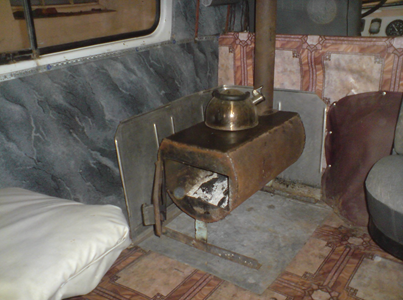
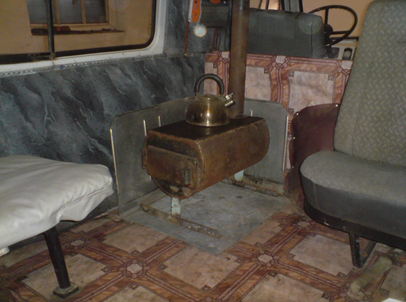
By 2016, the Loaf (if officially a cargo-passenger UAZ) has been repeatedly retired.
However, the demand for an unpretentious, cheap, domestic car in the open spaces of our Motherland, especially in the outback, is so great that every time the Phoenix bird is reborn.
And even such a patriarchal class of cars affected the change.
In short, consider what has changed and what has not. (For example, UAZ-390995 release in 2012)
![]()
The first thing that immediately catches the eye is the ZMZ-409 engine.
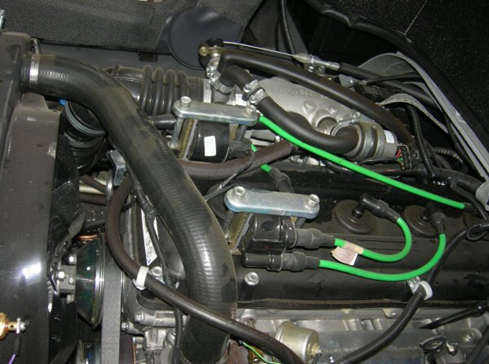
Now it meets the EURO-3 standards, for which a catalyst is installed in the exhaust system.

Motor very closely in the compartment. There and 417 engine was cramped, and even modern injector and even more so.
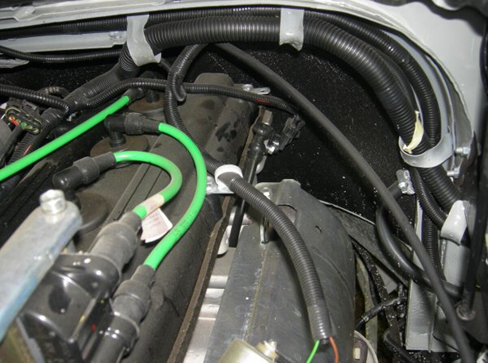
To replace the fourth candle even had to make a technological hole in the casing.
In the picture it can be seen closed rubber stub.

But now in the cabin, in the standard configuration, a folding table, two quick-detachable (with a screwdriver) stools and a back sofa.

Behind the passenger seat, as well as before, an additional cabin heater is installed.
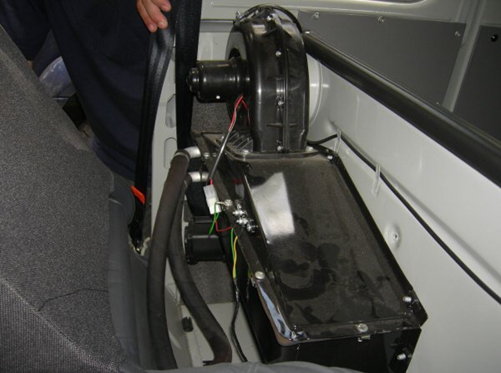
And behind the driver's seat, along with the familiar battery, is the engine control unit.
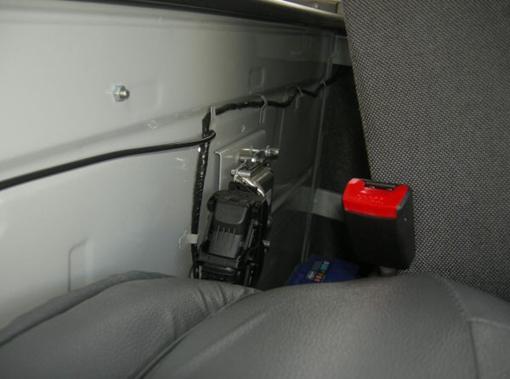
Seats with headrests, but without longitudinal adjustment. This is due to the fact that there is very little space in height between the front wheel arch and the roof. And the installation of any mechanism will steal precious centimeters. Therefore, the seats are mounted as in the old days - with the help of staples and ears.
Disappeared one of the steps (left) on the bumper. Instead, now "dummy". The massive hook, for the sake of safety standards, also sank into oblivion.
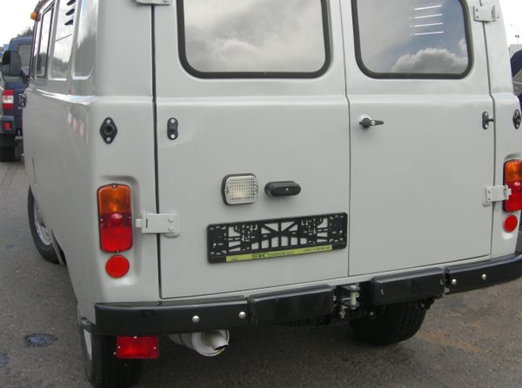

And for some reason, even the steering wheel is installed old, hard
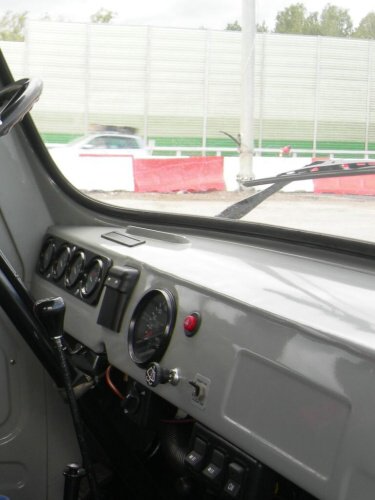
Although on the passenger line (,) the steering wheel is set to “soft”, two-spoke. True in that line still present power steering and ABS! So, apparently, this grade 🙂
The low / high beam switch stayed there too - on the floor:

And the head light switch is the same. (Tumbler gas tanks, apparently, it was decided to stand in the same style)
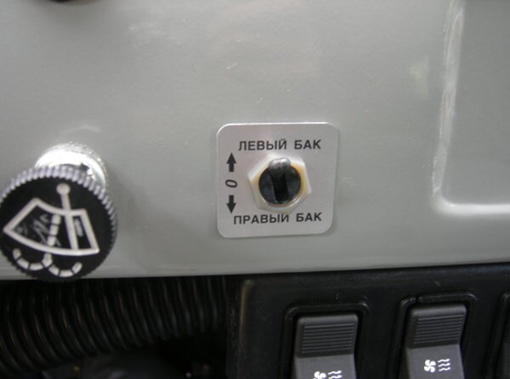
Not pleased with the quality and aesthetics of welds. 🙁 As well as hardboard as a finishing material. ( Hardboard - material obtained by hot pressing the mass or drying wood-fiber carpet (soft fiberboard), consisting of cellulose fibers, water ...)
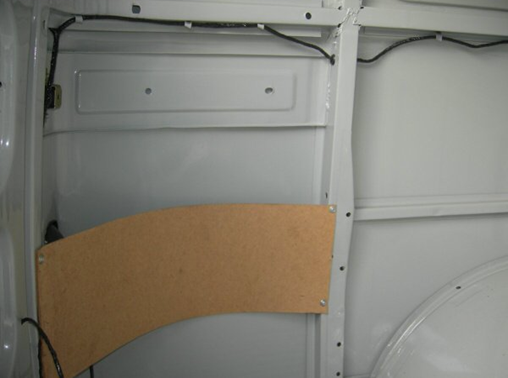
In general, as was a loaf designer, and remained. After the purchase, you need to immediately roll up your sleeves and engage in improving: warming, sealing, reassembling, installing music, communication, improving ventilation, etc.
This article explains what you should pay attention about buying a used. I collected most of the information when I was preparing to buy a UAZ for myself, and then I added and corrected the text, taking into account my own walking on the rake 🙂 The article about buying a UAZ 3151x, known as the “goat”, but most of the information is relevant for fans of such a wonderful car, as a "loaf".
What to ask by phone
Of course, abortions on the phone do not. In the sense - do not buy a car. But then you can decide whether to go for a car inspection or not. It should be borne in mind that the seller’s opinion is often subjective and biased. As well as the buyer 🙂
year of manufacture, color, mileage, initial cost
body condition (corrosion, repainted, anticorrosive, dents)
roof (metal, native, factory installation)
type of bridges (gearbox, collective farm, spicer)
fuel and engine oil consumption
type of suspension (spring or spring front)
the presence of GUR
general condition of the car (from the seller’s point of view)
rework of the owner
problems with the numbers of the body, frame (chassis), engine
the number of car owners since its acquisition
place of last registration
possibility of withdrawal / registration
Where to look at the parking lot
A fully operational UAZ does not happen, nor is it completely broken 🙂 Most faults can be fixed without consequences - the only question is the necessary time and money.
Engine
Before the appearance of Hunter, carburettor engines were regularly installed (the higher on the list, the more common):
UMP 417 - 2.4 l., Liner
UMP 421 - 2.9 l., Not gilzovanny
ZMZ 402 - 2.4 l., Gilzovanny
ZMZ 410 - 2.9 l., Liner
The ZMZ 409 - 2.7 liter is installed on the Hunter., Not gilzovanny, injection
More information about the engines of the UAZ can be found on the UAB.
should start 🙂 There should not be blue or black smoke from the exhaust pipe. From the oil filler neck (open the lid carefully) and the crankcase exhaust hose (remove from the air filter) should not BOTHLY smoke. We ask someone to gazanut a couple of times when we look at the exhaust and crankcase gases. Carefully (with a clever look) we listen to the engine in different modes. Valves may knock - thermal gaps are often not adjusted. But in general, no knocks and ringing should not be. From the bottom of the engine are looking for drips of oil. A dry UAZ engine is a fantasy (especially a carburetor) and a drop on the bottom cover of the clutch housing is an indispensable attribute. But the streaks should not be abundant and there should not be puddles under the car.
Also check:
Lubrication system
For carburetor engines, an oil pressure of 4 kgf / cm2 is good, 1.2 kgf / cm2 is minimum. The oil should be on the upper level, without foam, strange impurities and bubbles (look at the oil dipstick).
Compression
It is worth checking if the condition of the engine raises doubts 1.0 MPa - good, 0.6 MPa - at least, it is important to have a uniform compression on all cylinders.
Cooling system
Check the presence of antifreeze in the expansion tank. Antifreeze should be clean and transparent, without oil stains and stains. There should be no leakage of antifreeze on the radiator and engine. The engine should warm up to 75-85 degrees and keep a constant temperature.
Generator
When driving or a small run-in on the plus of the battery should be about 14 volts. On the twentieth, at least 12. Usually, a display meter on the dashboard is sufficient.
- Oil pressure is measured at a speed of 60 km / h with the direct gear engaged and the oil cooler off. At XX, the oil pressure will be lower. For a rough estimate of pressure, you can simply turn off. Usually, a built-in oil pressure gauge and display meter on the dashboard is sufficient.
- It makes sense to measure compression if the engine has a large mileage (more than 80 thousand km.), If it pulls badly or troit. If the oil pressure is low or the oil pressure sensor / display does not work. You can read more about the measurement of compression and how to interpret the results. For a UAZ carburetor engine, compression should be at least 6.65 kgf / cm2 (660 kPa). The pressure difference in the cylinders should not exceed 1 kgf / cm2 (98 kPa).
Body
The main problem of the body - corrosion. Here a lot depends on the owner.
Places where rust is stronger and more often:
Side racks coming from the floor to the dashboard, especially at the joints with the floor
Attachment points of the rear seat (there are swivel brackets - dies around them)
Joints with sealing rubber windows, especially the windshield frame
Often the rottenness of the body appears under the plastic bodywork
Expected holes or strong rust in the floor in the area of the driver’s door step, under the pedals
Thresholds rust from the inside - dirt and moisture accumulate there.
Rear skirt - look at the body below the rear lights
Checking:
Doors - the work of locks when closing, the gap above and below the door
Do the bolts of body pads to the frame stand straight (body displacement in an accident).
Transmission, Steering and Brakes
Unlike the engine on the nodes of the transmission should not be drops of oil. We look at the gearbox, RK, GP of the front and rear axles, and on military bridges there are also onboard gearboxes. None of the above should make noise on the move when driving under load, coasting and engine braking. The exception is the RK with spur gears can rattle in engine braking mode, as well as sometimes under load.
Steering should be without strong backlash and jamming.
PPC should allow gears to be included easily and without loss. There should be no extraneous noise, except for a low "click" and a loud "grrrr-rr-r" when you turn on the 1st and 2nd gear for 4-speed. Gearbox old sample.
The front axle and downshift should be engaged (hubs on the front wheels should be included)
Pivots should not have a backlash (shake the top of the front wheels - there should be no backlash)
The minimum run-down with the gear off at a speed of 50 km / h is 400 m. Unfortunately, when buying, the run-down is usually impossible to estimate.
The brakes should be grasped from the first press, the effort should not be very large. When braking the car should not lead to the side.
The needle bearings of the cardan shafts should not play completely, the splined joint should have a slight backlash - the cardan should not swing up and down by more than 2-3 mm.
Cardan can decently play if rotated. But the gap should not be in the cardan joints, but in the bridge and the RK / CAT. So on most of the UAZ.
On old and heavily rusted machines, it is worth checking the condition of the drain / filler plugs of the aggregates (have the allen key not cut)?
- How to distinguish partially synchronized gearbox. Double squeeze and peregazovka.
Frame
In addition to the oil drips and cardan, lying under the car is to inspect the frame. The frame may be rusty, but must be strong. Usually, problems with the frame are only for fairly old cars (destruction by corrosion) or those who have been in very serious trouble (deformation). Rust frame is the hardest at the articulations. We look at the fastening bolts of shock absorbers, springs, stepladders bolts. It should all look neat, strong rust is bad. After all, these nuts once need to be unscrew! Check the mounting brackets for the rear shock absorbers, the mounting of the rear springs - they can be turned off on the old frames
Rest
Worth seeing tires: Rubber must have uniform wear - this is important! We take the owner of the TCP or CP and look for or ask to show the number of the body, engine, frame (chassis). It is especially interesting to see the frame number - it is often erased with rust, but is indicated in the TCP and CP. Then there will be a red tape on the examination and amendment of the TCP. Not critical, but takes some time.
In addition, you can check all sorts of stuff that is easily repaired, but allow you to bargain.
Among them:
wipers and washer glass signal
stove
low and high beam
turn, brake and reverse signals
operation of fuel level sensors
tightness and bruise of tanks.
important for pontovyh clowns like hunters - fishermen, well, for all normal Siberian men ...
About a month ago, he opened the engine compartment from the cabin side, sawed out the opening in the dimensions of the stove. From scraps of the ventilation sleeve, galvanized, in short, made the wall from the stove to the hood and went to test in. During this time, in the forest, it pressed under -48 ° C, but it is normal to sleep in a car, it is warm, the only thing you throw in fire at 12 o'clock in the morning is firewood, close the air and fall asleep. At 5 am you usually get up from the cold, throw wood on the remains of coal, tea in a mug on the table freezes, and when there is no-30C, the tea does not freeze, that's the whole difference. It became very easy to warm up the engine! You will burn one or two fires of small dry wood in the stove, depending on the frost, heat the oil in the crankcase and gearbox-RK with a blowtorch for 5-7 minutes and the engine starts up with a half-kick - his head is already hot. The battery is cold in its compartment, I take it off, put it on the hood, throw 2 occasions from it to the terminals, so that the lighting, radio, and radio tape recorder would work. In short, the stove is heated - the hood is hot. Beauty! A dream come true idiot.

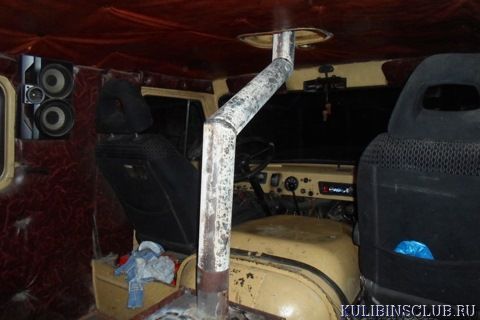
I did not touch the roof, I used the hatch for lifting the engine - in its place I cut out an exact copy of it with millimeter iron with a hole for the pipe with the same screws. The pipe in this case does not steal the living space in the cabin, the knee is also designed so that it would not interfere with raising the hood. The pipe to the stove is joined with the help of a wide ring cut out of the resonator of the GAZ-66 muffler - the 105 pipe comes in tightly.
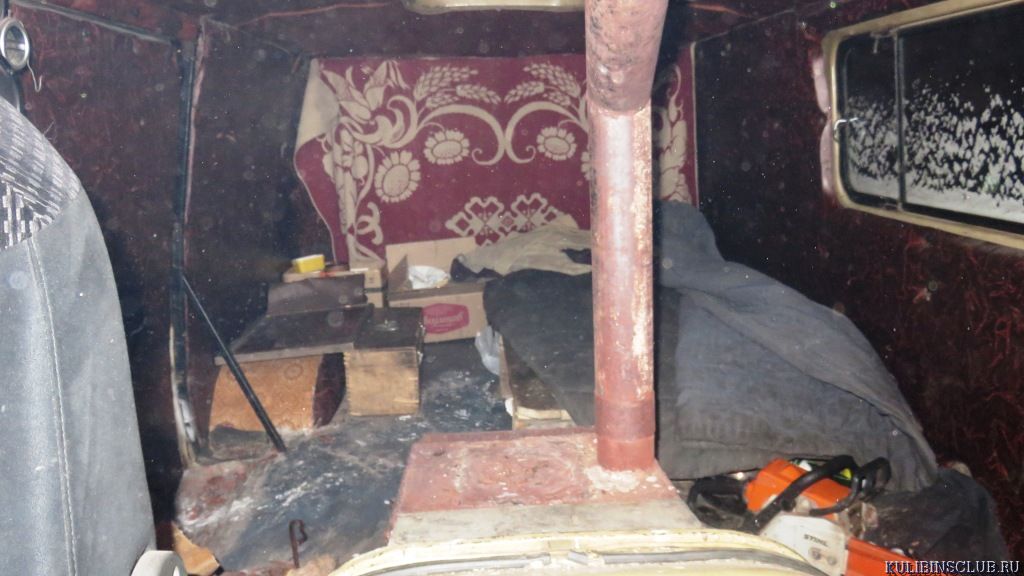
Naras, a table - it all adds up in a heap and does not interfere with carrying other junk when moving - traps, bait, a supply of firewood, an ice bag, and a radio receiver antenna passes through the air vent. Rear doors, in the cracks and glass (glass is a bridge of cold) which penetrates the cold, curtain curtain, it's easier.
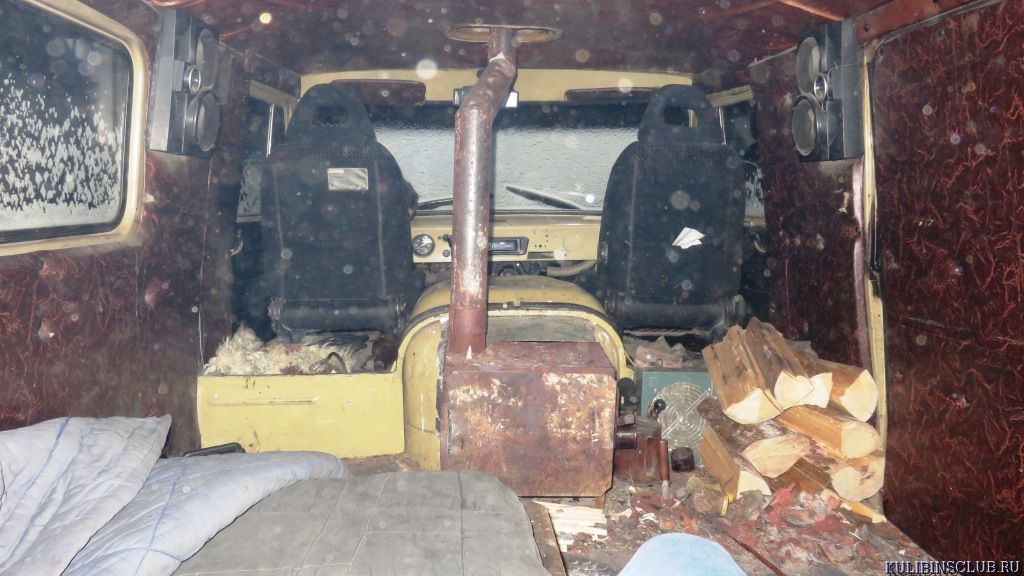
The front seats from the foreign cars move forward, you hang up the clothes that have become dampened during the day to dry, and the boot is usually thawed on the hood. Generally, despite the fact that the entire cabin is wrapped in a canvas tent from top to bottom, there is much cooler there - a refrigerator. A kettle with a brew, butter can be put in the legs of the passenger seat.
